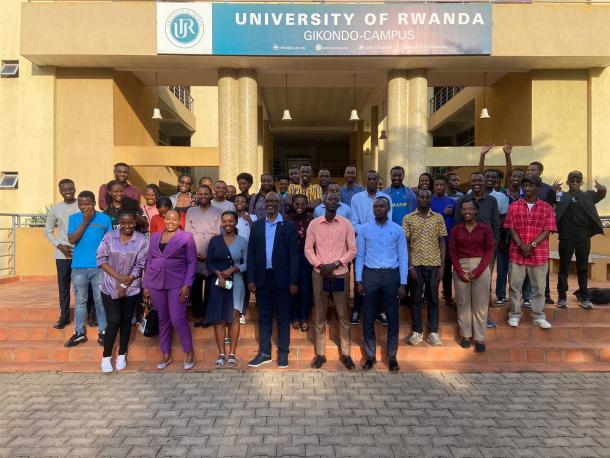On 13 February, the establishment and launch of the Students’ Creative Society brought together approximately 50 students from the University of Rwanda, Gikondo Campus. Also in attendance were representatives from the creative industries, including personnel from Museum Ingabo, the Rwanda National Commission for UNESCO, the University’s Department of Career and Student Employability, university alumni leaders, and other key stakeholders.

Supported by UNESCO, the launch and establishment of Student Creative Societies (SCS) in Rwanda is an initiative aimed at fostering vibrant communities of artistic expression and cultural engagement. Aligned with UNESCO’s commitment to strengthening cultural and creative industries in Africa and stimulating youth employment, this initiative—led by Snake Nation—provides skill development, industry exposure, and opportunities for student-led projects in music, film, fashion, dance, and technology. The current launch is taking place at Kepler College.
The launch event commenced with opening remarks Ms. Françoise, the Career and Employability Officer at the University of Rwanda, emphasizing the importance of career development in the creative industries. she highlighted the university’s commitment to equipping students with the necessary skills to thrive in Rwanda’s evolving digital and creative economy.
The keynote address, on "The Future of Africa’s Creative Economy," provided insights into the vast potential of the creative and cultural industries. Innovation, digital transformation, and policy support were underscored as key drivers for sustainable growth. Additionally, the role of international organizations in fostering creativity and culture as economic development tools was highlighted, with a strong emphasis on employment opportunities for youth across the continent.
A country address was also delivered, shedding light on Rwanda’s dedication to promoting culture and creativity as part of its national development agenda. Current initiatives to safeguard intangible cultural heritage were outlined, along with opportunities for students to engage in research, advocacy, and creative storytelling to further these efforts.
The discussions delved into the impact of student-led creative societies in shaping Africa’s digital future. Conversations revolved around fostering innovation, providing platforms for young creatives to develop their talents, and addressing the critical need for mentorship, funding, and institutional support. Academic institutions were urged to integrate creative industries into their co-curriculum, with a focus on areas such as digital storytelling, cultural entrepreneurship, and AI-driven creative solutions. The enthusiasm expressed by lecturers signaled a shift toward embracing the creative economy as an essential component of higher education.
One of the key moments of the event was the launch of the Students Creative Society, an initiative designed to nurture talent and provide opportunities for young creatives to showcase their work. The society encourages innovation and fosters a competitive yet supportive environment for university students in the creative field. An essential component of this initiative is the development of an online platform that will serve as a digital hub for showcasing student projects, facilitating knowledge-sharing, and connecting young creatives with global opportunities. This platform is expected to bridge gaps in access to creative resources while positioning Rwanda’s emerging talent on the international stage.
The launch of the Students’ Creative Society represents a transformative milestone in empowering young creatives. It aligns with the objectives of the 2005 UNESCO Convention on the protection and promotion of the diversity of cultural expressions, while ensuring creative opportunities are created for the youth which will have a triple effect in the economy. By strengthening Africa’s creative industries, this initiative ensures that young people are equipped with the skills, networks, and resources needed to succeed in an increasingly digital and interconnected world.
As Rwanda continues to position itself as a hub for innovation and creativity, the Students’ Creative Society stands as a testament to the power of youth-driven change, fostering a vibrant and sustainable creative economy for future generations.
"This initiative is a reflection of the dedication to empowering students to become future leaders in the creative economy. The industry is growing, and it is essential to provide students with the tools, networks, and knowledge to navigate and succeed in this space." said Ms. Francoise, Career and Employability Officer, University of Rwanda, Gikondo Campus.
"We appreciate the launch of this Student-led creative society as it will act as a bridge between academic learning and real-world creative industries, create more opportunities for young people to experiment, collaborate, and showcase their talents." said Ms. Sezerano Naradah, student leader- Secretary General position, University of Rwanda, Gikondo Campus.
| 空鼻症是什么 | 什么是静电 | 肾结石挂什么科室 | 禁欲什么意思 | 什么家庭养出自私冷漠 |
| 心肌缺血吃什么食物好 | 偏安一隅是什么意思 | 亢进是什么意思 | 猪下水是什么 | 燕窝什么时候吃最好 |
| 不排卵是什么原因造成 | 指甲断裂是什么原因 | hpv什么病毒 | 固液法白酒是什么意思 | 小腿疼痛为什么 |
| 蛇鼠一窝指什么生肖 | 吊儿郎当是什么意思 | 儿童病毒感染吃什么药 | 第一次怀孕有什么反应 | 望而生畏是什么意思 |
| 干戈指什么hcv8jop9ns8r.cn | 什么是记忆棉hcv8jop9ns4r.cn | 五官端正是什么意思hcv8jop3ns0r.cn | 董监高是什么意思hcv9jop2ns9r.cn | 撸管什么意思hcv7jop6ns2r.cn |
| 高血压吃什么中药hcv8jop3ns2r.cn | 为什么会岔气hcv9jop0ns5r.cn | 学信网上的报告编号是什么hcv9jop4ns2r.cn | 脂肪是什么颜色hcv7jop6ns5r.cn | 过敏性紫癜是什么原因引起的sanhestory.com |
| 坐月子哭了会有什么后遗症hcv8jop6ns2r.cn | 突破性出血是什么意思hcv7jop5ns0r.cn | 干咳无痰吃什么药hcv8jop7ns6r.cn | 葫芦什么时候成熟hcv9jop6ns9r.cn | 什么的少年zhiyanzhang.com |
| 89属什么bjcbxg.com | 牡丹花代表什么生肖hcv7jop4ns7r.cn | 乳腺结节钙化是什么意思hcv8jop5ns6r.cn | 梦见考试是什么预兆jinxinzhichuang.com | 恩师是什么意思hcv9jop2ns3r.cn |